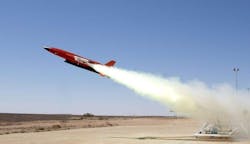Navy orders subsonic target drones and sensor payloads to help crews practice against anti-ship missiles
PATUXENT RIVER NAS, Md. – High-performance target drones experts at Kratos Defense & Security Solutions Inc. will build another 70 full-rate-production subsonic unmanned aerial targets designed to help Navy aircraft and surface warship crews learn to defeat enemy cruise missiles.
Officials of the U.S. Naval Air Systems Command at Patuxent River Naval Air Station, Md., announced a $57.7 million contract Tuesday to the Kratos Unmanned Systems segment in Sacramento, Calif., for 70 lot-5 BQM-177A surface-launched aerial targets.
The BQM-177A is the Navy’s next-generation subsonic unmanned aerial target (SSAT), which is designed to mimic the behaviors and radar cross sections of dynamic, high-subsonic, sea-skimming anti-ship cruise missiles to help naval personnel practice air-to-air engagements.
The contract includes 55 rocket-assisted takeoff attachment kits, 277 mission kits, and data for the U.S. Navy and the militaries of Canada and Australia.
The BQM-177A unmanned aerial vehicle (UAV) program will meet the U.S. Navy's requirements for a high fidelity target to mimic subsonic anti-ship missiles in fleet training and weapons testing.
In November 2016 Kratos Unmanned Systems officials announced they had achieved the final development program milestone for the BQM-177A target drone leading up to low-rate initial production (LRIP). In June 2018 Kratos began LRIP on the BQM-177A with a Navy order for 45 of the high-performance target drones. The company moved to full-rate production last year.
Capable of speeds in excess of 0.95 Mach and a sea-skimming altitude as low as 10 feet above the surface of the water, the BQM-177A carries internal and external sensor payloads including proximity scoring, identification friend or foe (IFF), passive and active RF augmentation, electronic countermeasures, infrared plume pods, chaff and flare dispensers, and towed targets.
The BQM-177A is based on the Kratos BQM-167X aircraft, a derivative of the U.S. Air Force BQM-167A Skeeter target. The BQM-177A introduces a new fuselage with area ruling, high-mounted wings, and an internally integrated MicroTurbo TR-60-5+ turbo jet engine for reduced transonic drag.
The BQM-177A will augment and later replace existing BQM-74E aerial targets, and will deliver longer range, lower cruise altitudes, and greater maneuverability than previous-generation target drones.
The BQM-177A is 17 feet long, has a 7 -foot wingspan, and weighs 620 pounds with fuel or payloads. It can fly at altitudes as low as 6.6 feet above the ground or water, and as high as 40,000 feet above sea level.
On this contract Kratos will do the work Sacramento, Santa Ana, Concord, and Chatsworth, Calif.; Dallas; Fort Walton Beach, Fla.; Blacksburg, Va.; Newton, Kan.; and Milwaukie, Ore., and should be finished by April 2026. For more information contact Kratos Unmanned Systems online at www.kratosdefense.com, or Naval Air Systems Command at www.navair.navy.mil.
